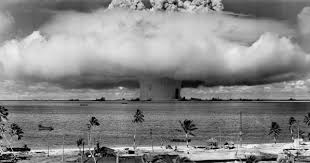 by Bruce Bethke
by Bruce BethkeFor three thousand years or more, the war canoe was the dominant way to project force on water. A party of men, rowing in unison with good coordination, can impart considerable energy and thus speed to their ship, a feat commemorated every time a coxswain and his crew put their racing shell on the Thames or the Charles. If your culture condones banditry and raiding—and what human culture hasn't, at one time or another?—a war canoe is a great way to raid. With careful timing you can sweep in from the sea, catch your victims unprepared, do your dirty business, and then, having smashed, burned, or stolen their boats, vanish again into the trackless sea. A party of raiders on horseback leaves a clear trail that retribution might follow, and horses must rest sometime. If you have a sail and a favorable wind, and are brave enough to sail in the dark, the only thing that stops or chases a party of raiders in a boat is a party of defenders in a faster boat.
I use the terms boat and war canoe loosely. The principle remained unchanged since the stone age, but the technology evolved considerably over time. The Greeks and their cultural descendants, the Romans, made their boats larger and faster by stacking banks of oars, first by twos and threes, making biremes and triremes, and eventually taking the concept as far as they could, so that quinqeremes and septiremes approaching 300 feet long were not unknown. The Viking longboats of the Ninth Century also were not tiny things; 100- to 150-foot boats with crews of forty to eighty men were common and are well-documented, and the sagas record that King Canute's great drakkar was more than 260 feet long and crewed by more than 120 Viking warriors. (Although as Björn Landström observes with typically Nordic humor, "But it occasionally happens that the sagas exaggerate.")
In the Mediterranean at the beginning of the First Millennium, the swift Roman triremes made the sea a "Roman lake" and for the two centuries of the Pax Romana piracy was suppressed, trade flourished, people grew rich, and as always happens when people are affluent, well-fed, and feel secure, culture blossomed. (It is also perhaps worth noting here that the Pax Romana applied only to people within the Empire, and there were near-constant skirmishes with the savages and barbarians on the borders the entire time. The Romans never tried to bring peace to the whole world; just to their world.) The Roman trireme, as it evolved over time into the Byzantine and Venetian galley, remained the dominant expression of naval force on the Mediterranean and Black seas for a thousand years after the fall of Rome, well into the 15th Century and beyond.
At the other end of the First Millennium, and on the other side of Europe in the North Sea, the swift Viking drakkars brought terror, death, and Scandanavian Y-chromosomes to people from Ireland to Moscow and as far south as Normandy, although, not to take anything away from anyone's beloved Viking ancestors, their feats of seamanship were not all that astounding and their ferocity not all that terrible. The Vikings were able to raid the British Isles mostly by island-hopping down through the Shetlands and Orkneys, and until the great leap to Iceland the largest expanse of open water they ever crossed was about 150 miles, which in a good ship with favorable weather is little more than a day's jaunt. Then, at the terminal end, they had the perversely good luck to fall upon what had up to that time been a fairly peaceable and quiet backwater of Christendom, populated by people who largely believed in that "turn the other cheek" business. The "Onward Christian Soldiers" brand of Christianity we know today was largely a development of the early to mid Second Millennium, and was a sort of societal immune system reaction by Christian Europe to pressure from Vikings in the north, Turks in the east, and Moors in the south.
But we're getting ahead of the story.
(...to be continued...)












